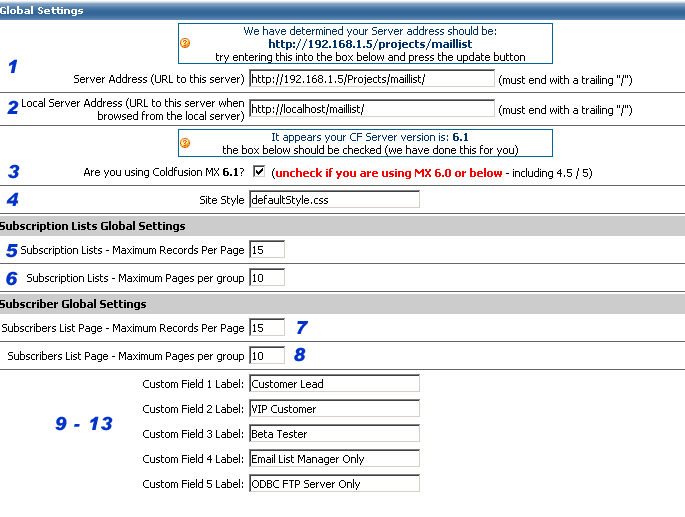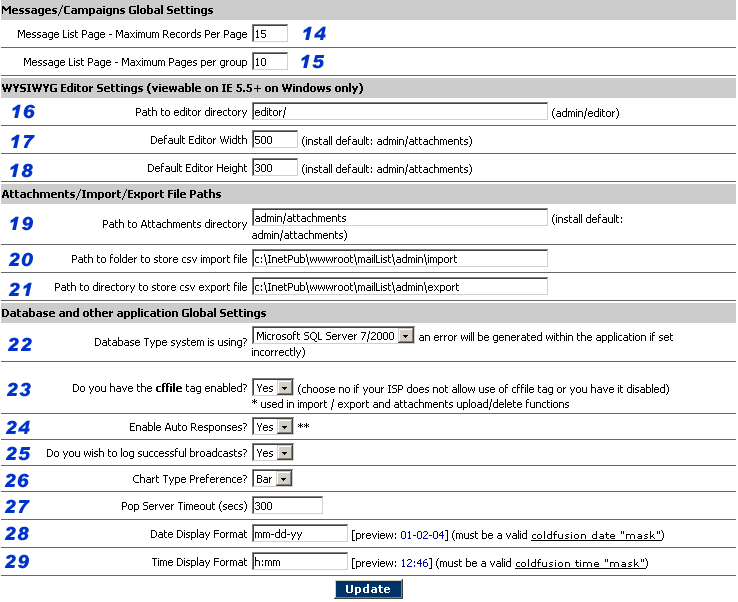
Column Explanation from top to bottom
1. Server Address
This is the full URL (address) to the root directory of the system
(with trailing /). This URL must be set correctly as it
is used when a message is processed and click-thru links are created in
the message. When this is done all links are replaced with a URL that leads
to the redirect.cfm file in the root level of the system. Therefore you
should be able to append redirect.cfm to the immediate
end of the url you enter above and you should be able to reach the redirect.cfm
file in the root folder from anywhere on the internet.
* Note this should not be an internal address such as 127.0.0.1 or localhost
as this will cause broken links in your email messages as these addresses are
not publicly accessible internet addresses
2. Local Server Address
This is the full URL (address) to your installation when accessed from
the local server (with
trailing /). This URL must be set correctly as it is used when all scheduled
tasks are created on the server. This setting has been added for better support
of running scheduled tasks on server behind firewall's, in such cases the local
server cannot access the web site via a fully qualified url. Examples would be
http://127.0.0.1/maillist/ (this would follow the same format used by CF Administrator)
3. Are you using Coldfusion MX (6.1)
Ensure you check this box if you are using MX (6.1), if you are using
version 4/4.5/5/MX then make sure you uncheck this box and press the "Update" button.
By default this is checked assuming your version is MX (6.1) *If
you are still using MX 6.0 you should upgrade as soon as possible performance
and cfmail tag are considerably improved
4. Site Style
There is a Styles directory at the root level of the main directory
that stores external style sheets for the system. As they become available
we will make available new style sheets for download from our web site that
you can add to this directory and use as an alternate style scheme for the
site. if you have more than one style sheet in this directory then updating
the name of the style sheet you wish to use in this box which change which
style sheet is used throughout the system. (currently this feature is not
used)
5. Subscription Lists
- Maximum Records Per Page -
allows you to define how many Subscription lists are displayed per page
view
(only used when you have set up more than 1 list)
6. Subscription Lists - Maximum Pages
per group- allows you
to define how many pages are displayed per grouping. This is used when there
are multiple pages to scroll through you will have a link displayed as
<< Page 1 2 3 4 5 >> In this case the page group would be set at
5
7. Subscribers List Page
- Maximum Records Per Page -
allows you to define how many Subscribers are displayed per page view
(only used when you have many subscribers in the system)
8. Subscribers List Page - Maximum
Pages per group - allows
you to define how many pages are displayed per grouping.
9 - 11 Custom Field Names -
You can now setup your own extra "custom fields" in the subscribers table,
currently 5 custom fields are available, when in the subscribers screen
you will see these fields listed in the Add New window and also the detail
pop-up window for updating a subscribers extended information. Here you
can assign a descriptive name for each field if you plan on utilizing
them so that they will be easy to remember when you are using them throughout
your application. Once you assign a name to the custom field here then
this name will appear throughout the application in place of "Custom
Field 1/2/3/4/5". This is a very powerful tool allowing you even
greater control over storing demographic information on your subscribers.
These fields can be searched on to create subscriber groups and more.

15. Message List Page - Maximum Pages per group - allows you to define how many pages are displayed per grouping.
16. Path to editor directory - this is the path to the "admin/editor" directory and is relative to the admin directory being root (it is not advise to move this directory or change this setting).
17. Default editor width - the WYSIWYG editor used through the application can be resized within the application, you can set its default width here.
18. Default editor height - the WYSIWYG editor used through the application can be resized within the application, you can set its default height here.
19. Path to the directory storing all message attachments
Set the relative path (form the maillist directory) to the folder you wish to store the uploaded attachments (requires use of cffile tag)
20. Path to folder to store csv import file
Set the full path to the folder you wish to store the uploaded copy of a CSV file which you wish to import a subscriber list from (requires use of cffile tag)
21. Path to folder to store csv export file
Set the full path to the folder you wish to store the created csv file which will be created from an export request (requires use of cffile tag to create and write a csv file to the server, if setting below is disabled then an export will still be processed and the output will be output to screen as a comma delimited text file that you can copy and paste to a text file and then import easily into Microsoft Excel manually)
22. Set the database you are using here? This will be set already to the database you chose during setup so will usually not require modification, it is important this is set to the correct database type you are using as there are some slightly different sql syntax used by different databases.
23. Do you have the cffile tag enabled?
Set this to "Yes" if are able to use the cffile tag on your server (please check with your ISP if unsure as many ISP's disable this tag by default for security reasons)
24. Enable Auto Responses?
Set this to "Yes" if wish to enable auto response messages to be sent when a user successfully subscribes or un-subscribes to your list (via your web site and using the subscribeEngine.cfm custom tag to commit the subscriber to your list). This also requires you create Auto Response messages for subscribe and unsubscribe requests.
25. Do you wish to log successful broadcasts?
Set this to "Yes" if wish to log every successful address a message has been sent to, this is purely a logging feature that can be useful in viewing which subscribers were sent a message and which weren't if for example you broadcast failed part of the way for some reason.
26. Chart Type Preference?
In the click thru stats screen (if click thru stats are present) you will have the option to view a graph representing your click through's received for that message, you can set here if you wish to to be displayed as a bar graph or pie chart.
27. Pop Server Timeout?
You can set the default pop server timeout for the system here, this is used when requests are made to your POP3 server to retrieve all messages for your list's address (these messages may contain bounces, subscribe or un-subscribe requests). This can be useful if you are having problems with a slowly responding mail server.
28. Date Display Format?
You can set the global date display format that will be used whenever date's are displayed throughout the system, this must adhere to the date masks as defined in the ColdFusion documentation for the DateFormat tag.
examples include:
mmm-dd-yyyy
mmmm d, yyyy
mm/dd/yyyy
29. Time Display Format?
You can set the global time display format that will be used whenever time is displayed throughout the system, this must adhere to the time masks as defined in the ColdFusion documentation for the TimeFormat tag.
examples include:
hh:mm:ss
hh:mm:sst
hh:mm tt